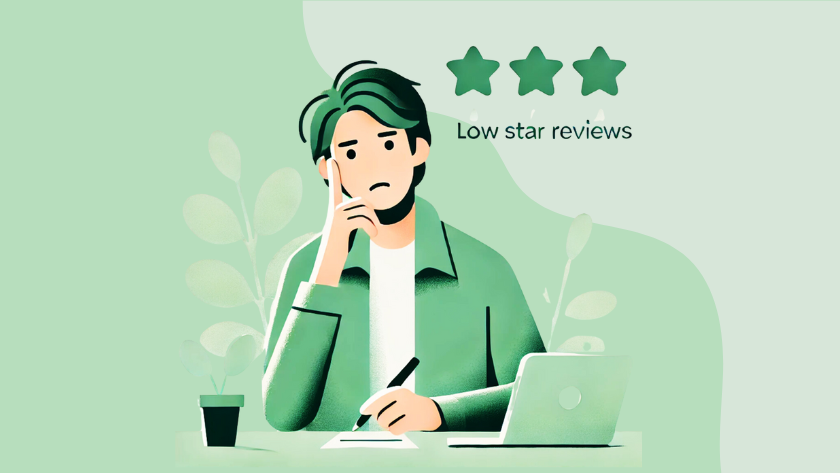
The dreaded 1-star review: does it spell disaster, or is it actually the best marketing tool you didn’t know you had?
You’ve poured your heart into your book, meticulously editing, polishing every chapter, and carefully choosing a cover that speaks to your target audience. You thought you did everything right. So when that 1-star review pops up, it’s hard not to take it personally. It’s natural to feel frustrated—no author feels joyful when their hard work is dismissed with a single star. The initial reaction is often filled with self-doubt and questions like, “Did I miss something? Is my story really resonating?”
But once you’ve had time to process your emotions about the not-so-stellar review, it’s important not to it derail your momentum. Instead, think of it as an opportunity to make your book stand out even more. In this article, we’ll explore how you can transform 1-star reviews into a strength with real-world strategies taken directly from authors who have used them successfully.
The Emotional Impact – Allow Yourself to Feel It, But Don’t Stay There
When a 1-star review appears, it’s easy to become overwhelmed. You might find yourself questioning the reviewer’s motives, wondering if they realize how much effort went into your book, or how crucial positive reviews are for sales. It’s completely normal to experience a range of emotions, from disappointment to anger, and to ask yourself why you even wrote the book in the first place.
However, after processing these feelings, it’s time to dust yourself off and figure out your next move. Don’t let a low-star review hold you back from promoting your manuscript. Instead, what if you saw it as a chance to set your book apart and engage your audience in a unique way?
Identifying Patterns in Feedback: Action Plan
Sometimes, you’ll find recurring themes in low-star reviews and this is where you can get some valuable feedback if you’re open to it. By sorting through the various reviews with similar observations, you can uncover areas for improvement. Here are a few ideas on how to address common critiques:
- Confusing Plot or Typos
- Feedback: “There are time lapses I don’t understand, and I just couldn’t get past all the typos.”
- Action: Revisit the manuscript for plot inconsistencies and consider another round of proofreading. It may be helpful to hire a professional editor to catch what you’ve missed.
- Unrelatable Characters
- Feedback: “The characters just weren’t relatable.”
- Action: Add more depth and motivation to your characters to help readers connect with them. Here are five character development tips to get you started.
- Content Warnings or Expectations
- Feedback: “There’s too much violence in this book, and I didn’t expect it to be open-door romance.”
- Action: Include trigger warnings on your sales page and in your book’s front matter to set expectations, potentially reducing negative feedback related to content surprises.
Leverage Low-Star Reviews to Your Advantage
Now this is where things get interesting. If a review is bizarre, irrelevant, or overly harsh, it can be flipped into a marketing tool. For example, if someone says, “This book offended me in every sense,” you could feature that line in a social media post to spark curiosity. Who wouldn’t want to know what’s so offensive?
Or if a reviewer complains that your horror book “too scary,” highlight that in your marketing to attract readers who love a good scare. Here are some more ideas shared by real authors, on how they are using negative reviews as a promotional tool:
- Contrasting Reviews Technique
- Consider showing the 1-star review alongside a 5-star review with opposing viewpoints. If one review says, “Too much romance,” and another says, “Not enough romance,” it shows that your book evokes strong opinions and invites curiosity.
- Feature One-Star Reviews in Your Promotional Content
One author suggests using memorable quotes from low-star reviews in social media graphics. For instance, a line like “offensive in every sense” could be paired with bold text like, “Want to see what all the fuss is about?” – challenging readers to experience the story firsthand. - Turn a Negative into a Challenge
If a reviewer warns, “Don’t read this book unless you’re ready for nightmares,” it could be flipped into a dare for your audience—“Are you brave enough to give it a go?” - Embrace Humor
When a review is overly critical, pompous or bizarre, sharing them with a twist of fun can be a great way to add character to your brand. This brings your personality to life and can also endear you to your audience by showing that you don’t take yourself too seriously.
The Positive Side of Negative Reviews – Boost Credibility
The motivation behind leaving a 1-star review isn’t always clear, but consider this an opportunity to prove that your book made an impact. Think of it this way: if someone felt compelled to leave a detailed critique, it means your book left a lasting impression. And try to remember that every reader is different and what they enjoy reading will vary, which gets reflected back to us in the form of the feedback they share. It’s up to you what you decide to do with that information.
Embracing negative feedback allows you to grow both personally and professionally, transforming perceived setbacks into opportunities for success. So, the next time you get a 1 or 2-star review, try not stress about it too long—get creative and spin it into marketing material that works for you.
Keep Learning and Evolving
Authors are always evolving, and growth comes from staying attuned to how readers respond to your work and marketing efforts. Pay attention to what strategies other successful authors use, and adapt their approaches to resonate with your audience. Remember, every successful author has faced criticism; how they respond often defines their success.
Leave a Reply